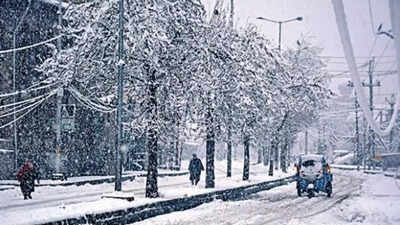Top Searches
Himalayan snow is turning black, melting faster: IITM

PUNE: A study by the city-based Indian Institute of Tropical Meteorology (IITM) has found that black carbon (BC) - a major component of soot and a pollutant emitted through biomass/ biofuel burning along with wildfires in Uttarakhand, Punjab, Haryana, the Indo-Gangetic Plains (IGP), Pakistan and the Middle East - is now darkening Himalayan snow cover and melting it faster, top scientists told TOI.
BC measurements spanning from June to October 2019 were carried out over an adjoining location of the Satopanth and Bhagirath-Kharak glaciers of the Central Himalayas by IITM. The findings from these observations have been published in the international journal, Environmental Research, in late 2021.
Abhilash Panicker, a senior scientist at IITM, told TOI, "The high rate of BC influx during June, September and October in 2019 was attributed to its transport from the polluted IGP region, wildfires, and vehicular emissions in the valley. The long-range transport of BC aerosols from Punjab, Haryana, Pakistan and the Middle East also contributes to BC presence over the study region. Higher influx was further linked to biomass burning, especially wood-burning, during intense forest fires at the slopes of the mountains."
Panicker added that higher BC concentrations over parts of Himalayas have been found to enhance snow darkening there. This refers to the reduction of reflectivity (albedo) of snow due to deposition of aerosols such as dust, BC and more.
"The influence of BC on radiative forcing (changes in solar radiation due to absorption by BC aerosols) can also lead to depletion or melting of snow cover. Our study showed that increased radiative heating due to near-surface atmospheric BC with the snow darkening effect induces additional warming, and possible changes of the natural snow cycle over the glacier in the form of faster melting," he said.
Another study published this year, led by Dr Vijayakumar S Nair from the Space Physics Laboratory at the Vikram Sarabhai Space Centre in Thiruvananthapuram, has echoed that snow darkening due to aerosol deposition accelerates seasonal snowmelt over the Himalayas. It said that aerosol influx can shift Himalayan snowmelt timing by over 20 days, while aerosol-induced surface warming can increase the occurrence of snowmelt extremes by almost twice during melting season.
Gufran Beig, founder of System of Air Quality Forecasting and Research (SAFAR) and a scientist with the National Institute of Advanced Studies (NIAS), Indian Institute of Science (IISc) campus, explained, "Biofuels and low temperature combustion are a major source of BC, the particles of which are smaller than particulate matter (PM) 2.5 and hence have a longer life span. They are transported over longer distances and get deposited on glaciers. Normally, aerosols reflect radiation - but BC act like greenhouse gases and absorb solar radiation. This leads to more heating when these particles deposit over snow cover, and faster melting. This, in turn, contributes further to global warming."
BC measurements spanning from June to October 2019 were carried out over an adjoining location of the Satopanth and Bhagirath-Kharak glaciers of the Central Himalayas by IITM. The findings from these observations have been published in the international journal, Environmental Research, in late 2021.
Abhilash Panicker, a senior scientist at IITM, told TOI, "The high rate of BC influx during June, September and October in 2019 was attributed to its transport from the polluted IGP region, wildfires, and vehicular emissions in the valley. The long-range transport of BC aerosols from Punjab, Haryana, Pakistan and the Middle East also contributes to BC presence over the study region. Higher influx was further linked to biomass burning, especially wood-burning, during intense forest fires at the slopes of the mountains."
Panicker added that higher BC concentrations over parts of Himalayas have been found to enhance snow darkening there. This refers to the reduction of reflectivity (albedo) of snow due to deposition of aerosols such as dust, BC and more.
"The influence of BC on radiative forcing (changes in solar radiation due to absorption by BC aerosols) can also lead to depletion or melting of snow cover. Our study showed that increased radiative heating due to near-surface atmospheric BC with the snow darkening effect induces additional warming, and possible changes of the natural snow cycle over the glacier in the form of faster melting," he said.
Another study published this year, led by Dr Vijayakumar S Nair from the Space Physics Laboratory at the Vikram Sarabhai Space Centre in Thiruvananthapuram, has echoed that snow darkening due to aerosol deposition accelerates seasonal snowmelt over the Himalayas. It said that aerosol influx can shift Himalayan snowmelt timing by over 20 days, while aerosol-induced surface warming can increase the occurrence of snowmelt extremes by almost twice during melting season.
Gufran Beig, founder of System of Air Quality Forecasting and Research (SAFAR) and a scientist with the National Institute of Advanced Studies (NIAS), Indian Institute of Science (IISc) campus, explained, "Biofuels and low temperature combustion are a major source of BC, the particles of which are smaller than particulate matter (PM) 2.5 and hence have a longer life span. They are transported over longer distances and get deposited on glaciers. Normally, aerosols reflect radiation - but BC act like greenhouse gases and absorb solar radiation. This leads to more heating when these particles deposit over snow cover, and faster melting. This, in turn, contributes further to global warming."

About the Author
Neha MadaanNeha Madaan is a senior feature writer at The Times of India, Pune. She holds an M A degree in Mass Communication and Journalism from University of Pune. She covers tourism, heritage development and its conservation, apart from an array of subjects such as civic issues, environment, astronomy, civic school education as well as social issues concerning persons with disabilities. Her interests include metaphysical research and animal rights.
Start a Conversation
FOLLOW US ON SOCIAL MEDIA
FacebookTwitterInstagramKOO APPYOUTUBE









